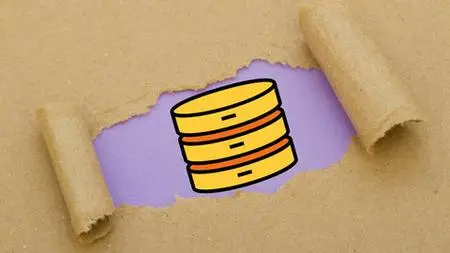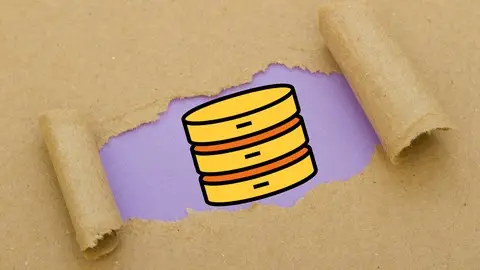Fundamentals Of Database Engineering
Last updated 11/2022
MP4 | Video: h264, 1280x720 | Audio: AAC, 44.1 KHz
Language: English | Size: 15.85 GB | Duration: 23h 30m
Last updated 11/2022
MP4 | Video: h264, 1280x720 | Audio: AAC, 44.1 KHz
Language: English | Size: 15.85 GB | Duration: 23h 30m
Learn ACID, Indexing, Partitioning, Sharding, Concurrency control, Replication, DB Engines, Best Practices and More!
What you'll learn
Learn and understand ACID Properties
Database Indexing
Database Partitioning
Database Replication
Database Sharding
Database Cursors
Concurrency Control (Optimistic, Pessimistic)
B-Trees in Production Database Systems
Database System Designs
Difference between Database Management System, Database Engine and Embedded database
Database Engines such as MyISAM, InnoDB, RocksDB, LevelDB and More
Benefits of Using one database engine over the other
Switching Database Engines with MySQL
Database Security
Homomorphic Encryption
Requirements
Have worked with databases before but wish to get deeper understanding
Basic SQL knowledge
Description
Database Engineering is a very interesting sector in software engineering. If you are interested in learning about database engineering you have come to the right place. I have curated this course carefully to discuss the Fundamental concepts of database engineering.This course will not teach you SQL or programming languages, however, it will teach you skillsets and patterns that you can apply in database engineering. A few of the things that you will learn are Indexing, Partitioning, Sharding, Replication, b-trees in-depth indexing, Concurrency control, database engines and security, and much more. I believe that learning the fundamentals of database engineering will equip you with the necessary means to tackle difficult and challenging problems yourself. I always compare engineering to math, you never memorize specific formulas and equations, you know the basic proves and derive and solve any equation one throws at you. Database engineering is similar, you can't possibly say MongoDB is better than MySQL or Postgres is better than Oracle. Instead, you learn your use case and by understanding how each database platform does its own trade-offs you will be able to make optimal decisions. One other thing you will learn in this course is the lowest database interface that talks to the OS which is the database engine. Database engines or storage engines or sometimes even called embedded databases is a software library that a database management software uses to store data on disk and do CRUD (create update delete) Embedded means move everything in one software no network client-server. In this video course, I want to go through the few popular database engines, explain the differences between them, and finally, I want to spin up a database and change its engine and show the different features of each engine. Enjoy the course.
Overview
Section 1: Course Updates
Lecture 1 Welcome to the Course
Lecture 2 Course Update Oct 2020
Lecture 3 Course Update April 2021
Lecture 4 Course Update December 2021
Lecture 5 Note about Docker
Section 2: ACID
Lecture 6 Introduction to ACID
Lecture 7 What is a Transaction?
Lecture 8 Atomicity
Lecture 9 Isolation
Lecture 10 Consistency
Lecture 11 Durability
Lecture 12 ACID by Practical Examples
Lecture 13 Phantom Reads
Lecture 14 Serializable vs Repeatable Read
Lecture 15 Eventual Consistency
Section 3: Understanding Database Internals
Lecture 16 How tables and indexes are stored on disk (MUST WATCH before continue)
Lecture 17 Row-Based vs Column-Based Databases
Lecture 18 Primary Key vs Secondary Key - What you probably didn't know
Section 4: Database Indexing
Lecture 19 Create Postgres Table with a million Rows (from scratch)
Lecture 20 Getting Started with Indexing
Lecture 21 Understanding The SQL Query Planner and Optimizer with Explain
Lecture 22 Bitmap Index Scan vs Index Scan vs Table Scan
Lecture 23 Key vs Non-Key Column Database Indexing
Lecture 24 Index Scan vs Index Only Scan
Lecture 25 Combining Database Indexes for Better Performance
Lecture 26 How Database Optimizers Decide to Use Indexes
Lecture 27 Create Index Concurrently - Avoid Blocking Production Database Writes
Lecture 28 Bloom Filters
Lecture 29 Working with Billion-Row Table
Lecture 30 Article - The Cost of Long running Transactions
Lecture 31 Article - Microsoft SQL Server Clustered Index Design
Section 5: B-Tree vs B+Tree in Production Database Systems
Lecture 32 B-Tree Section's Introduction & Agenda
Lecture 33 Full Table Scans
Lecture 34 Original B-Tree
Lecture 35 How the Original B-Tree Helps Performance
Lecture 36 Original B-Tree Limitations
Lecture 37 B+Tree
Lecture 38 B+Tree DBMS Considerations
Lecture 39 B+Tree Storage Cost in MySQL vs Postgres
Lecture 40 B-Tree Section's Summary
Section 6: Database Partitioning
Lecture 41 Introduction to Database Partitioning
Lecture 42 What is Partitioning?
Lecture 43 Vertical vs Horizontal Partitioning
Lecture 44 Partitioning Types
Lecture 45 The Difference Between Partitioning and Sharding
Lecture 46 Preparing: Postgres, Database, Table, Indexes
Lecture 47 Execute Multiple Queries on the Table
Lecture 48 Create and Attach Partitioned Tables
Lecture 49 Populate the Partitions and Create Indexes
Lecture 50 Class Project - Querying and Checking the Size of Partitions
Lecture 51 The Advantages of Partitioning
Lecture 52 The Disadvantages of Partitioning
Lecture 53 Section Summary - Partitioning
Lecture 54 How to Automate Partitioning in Postgres
Section 7: Database Sharding
Lecture 55 Introduction to Database Sharding
Lecture 56 What is Database Sharding?
Lecture 57 Consistent Hashing
Lecture 58 Horizontal partitioning vs Sharding
Lecture 59 Sharding with Postgres
Lecture 60 Spin up Docker Postgres Shards
Lecture 61 Writing to a Shard
Lecture 62 Reading from a Shard
Lecture 63 Advantages of Database Sharding
Lecture 64 Disadvantages of Database Sharding
Lecture 65 Database Sharding Section Summary
Lecture 66 When Should you consider Sharding your Database?
Section 8: Concurrency Control
Lecture 67 Shared vs Exclusive Locks
Lecture 68 Dead Locks
Lecture 69 Two-phase Locking
Lecture 70 Solving the Double Booking Problem (Code Example)
Lecture 71 Double Booking Problem Part 2 ( Alternative Solution and explination)
Lecture 72 SQL Pagination With Offset is Very Slow
Lecture 73 Database Connection Pooling
Section 9: Database Replication
Lecture 74 Introduction to Database Replication
Lecture 75 Master/Standby Replication
Lecture 76 Multi-master Replication
Lecture 77 Synchronous vs Asynchronous Replication
Lecture 78 Replication Demo with Postgres 13
Lecture 79 Pros and Cons of Replication
Section 10: Database System Design
Lecture 80 Twitter System Design Database Design
Lecture 81 Building a Short URL System Database Backend
Section 11: Database Engines
Lecture 82 Introduction
Lecture 83 What is a Database Engine?
Lecture 84 MyISAM
Lecture 85 InnoDB
Lecture 86 XtraDB
Lecture 87 SQLite
Lecture 88 Aria
Lecture 89 BerkeleyDB
Lecture 90 LevelDB
Lecture 91 RocksDB
Lecture 92 Popular Database Engines
Lecture 93 Switching Database Engines with mySQL
Section 12: Database Cursors
Lecture 94 What are Database Cursors?
Lecture 95 Server Side vs Client Side Database Cursors
Lecture 96 Inserting Million Rows with Python in Postgres using Client Side Cursor
Lecture 97 Querying with Client Side Cursor
Lecture 98 Querying with Server Side Cursor
Lecture 99 Pros and Cons of Server vs Client Side Cursors
Lecture 100 Article - Server Side Cursor Types in SQL Server
Section 13: Database Security
Lecture 101 How to Secure Your Postgres Database by Enabling TLS/SSL
Lecture 102 Deep Look into Postgres Wire Protocol with Wireshark
Lecture 103 Deep Look Into MongoDB Wire Protocol with Wireshark
Lecture 104 What is the Largest SQL Statement that You can Send to Your Database
Lecture 105 Best Practices Working with REST & Databases
Lecture 106 Database Permissions and Best Practices for Building REST API
Section 14: Homomorphic Encryption - Performing Database Queries on Encrypted Data
Lecture 107 Introduction to Homomorphic Encryption
Lecture 108 What is Encryption?
Lecture 109 Why Can't we always Encrypt?
Lecture 110 What is Homomorphic Encryption
Lecture 111 Homomorphic Encryption Demo
Lecture 112 Clone and Build the Code
Lecture 113 Going Through the Code and the Database
Lecture 114 Searching The Encrypted Database
Lecture 115 Is Homomorphic Encryption Ready?
Section 15: Answering your Questions
Lecture 116 Snapshot and Repeatable Read Isolation difference?
Lecture 117 I have an Index why is the database doing a full table scan?
Lecture 118 Why Databases Read Pages instead of Rows?
Lecture 119 How does Indexing a column with duplicate values work?
Lecture 120 Should I drop unused indexes?
Lecture 121 Why use serializable Isolation Level when we have SELECT FOR UPDATE?
Lecture 122 Can I use the same database connection for multiple clients?
Lecture 123 Do I need a transaction if I'm only reading?
Lecture 124 Why does an update in Postgres touches all indexes?
Lecture 125 What is the value of bitmap index scan?
Lecture 126 What does Explain Analyze actually do?
Section 16: Database Discussions
Lecture 127 SELECT COUNT (*) can impact your Backend Application performance, here is why
Lecture 128 How does the Database Store Data On Disk?
Lecture 129 Is QUIC a Good Protocol for Databases?
Lecture 130 What is a Distributed Transaction?
Lecture 131 Hash Tables and Consistent Hashing
Lecture 132 Indexing in PostgreSQL vs MySQL
Lecture 133 Why Uber Moved from Postgres to MySQL (Discussion)
Lecture 134 Can NULLs Improve your Database Queries Performance?
Lecture 135 Write Amplification Explained in Backend Apps, Database Systems and SSDs
Lecture 136 Optimistic vs Pessmistic Concurrency Control
Lecture 137 WAL, Redo and Undo logs
Section 17: Archived Lectures
Lecture 138 Introduction to ACID (Archived)
Lecture 139 What is a Transaction? (Archived)
Lecture 140 Atomicity (Archived)
Lecture 141 Isolation (Archived)
Lecture 142 Consistency (Archived)
Lecture 143 Durability (Archived)
Software Engineers and Database Engineers



